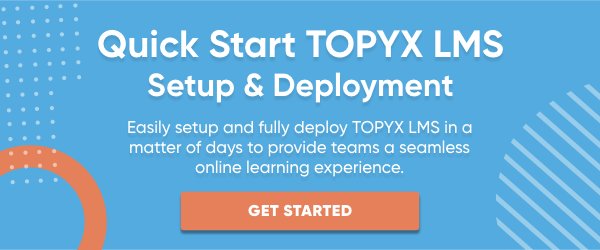Compliance regulations for employees of financial institutions have multiplied in recent years. Regulatory agencies such as the Federal Reserve, National Credit Union Administration, Consumer Financial Protection Bureau, and others have established over 2500 separate rules and regulations that financial institutions must comply with, per Deloitte.¹
As technology advances and the financial industry undergoes further changes, compliance regulations will continue to evolve to better ensure financial organizations conduct business and serve customers responsibly. That makes compliance-related financial services training and training audits essential.
Related Reading: Enhancing Financial Services Training and Onboarding With LMS Software
Training and auditing should evolve as needs change. Audits, in particular, should be an area of focus as they’re one of the best ways to determine how effective your financial services training is and where you need to fill gaps. Optimizing your audit process will not only make it more effective, but will save your staff time and effort ensuring everyone is up to speed.
3 Tips for Improving Regulatory
Compliance Training Audits
High levels of staff compliance help finance companies upgrade training strategies, reduce costs, enhance services, and provide better customer service, according to Increasing Regulatory Training Requirements in the Banking and Financial Industry.²
Improving the outcome of employee training audits for regulatory compliance is one of the key methods financial services companies use to ensure their employees aren’t endangering the business and are using best practices. Here are three ways finance companies can improve compliance training audits:
1. Measure training content retention
A compliance training audit is meant to gauge the effectiveness of regulatory training and help company leaders find and fill any gaps in training content.
The efficacy of your company’s compliance training is tied to how well the training is retained and applied by employees. Measure training content retention and how well it’s put into practice by “(Utilizing) knowledge and behavioral assessments that show retention of compliance knowledge over time and application to the job,” suggested Deloitte.³
Another way to gauge efficacy of compliance training is to look at the culture of your organization. Do you see a culture of compliance that is evident without analyzing data? The absence of this type of culture calls for a deeper inspection into whether or not training is being regularly used and retained. From there specific problems related to compliance training can be mitigated.
Related Reading: 3 Tips for Increasing the Effectiveness of a Financial Services Training Program
2. Combine comprehensive audits with spot audits
If your company has only a yearly audit, compliance is most likely not as strong as it could be. Supporting a yearly audit with smaller spot audits will often bring better results.
Comprehensive audits that cover all the details and outcomes of training should happen regularly, either on a yearly or bi-yearly basis, or anytime there’s a major change in regulations. But in addition to comprehensive audits, perform spot audits that dive into individual compliance requirements or remote training courses employees are required to take. Depending on your company’s needs, you might choose to spot audit several times a year.
The combination of comprehensive audits and spot audits will ensure that gaps in training and compliance don't sit without employees noticing.
Related Reading: Increase Employee Engagement with LMS Compliance Training
3. Use an LMS
Many companies in heavily regulated industries choose to use an LMS software for compliance training due to its exceptional tracking and reporting capabilities, as well as other features that promote employee training.
An LMS system keeps track of compliance course completion and certifications, providing detailed reports on who has taken what courses and when it’s time for re-certification if certification is required. An LMS organizes compliance training records and stores them in one secure, online location. This promotes an easier auditing process.
By delivering regulatory courses in a convenient online format, a learning management system supports the use of and participation in compliance training. Better compliance training audits will likely result.
Related Reading: What exactly is an LMS?
What Do Your Company’s Regulatory Training Audits Reveal About Staff Compliance?
Today’s finance professional must be highly ethical, technically skilled, and business savvy. He or she should have sufficient knowledge of investment products, costs and charges, market structures, valuation principles, portfolio management, and much more.4
Does your financial services staff comply with all applicable standards from regulatory agencies? Your audit process should help answer that question quickly. If the audit indicates compliance or training efficacy levels are low, you could be missing key gaps in your training or its on-the-job application that puts your organization at risk.
Take the time to improve your training audits so you have the insights you need to ensure all your staff are up to speed on regulatory compliance.
Start Offering Your Employees Mobile Learning Within Days
Companies that want to begin offering mobile learning or improve the mobile learning program they already have will benefit from TOPYX LMS. Launch TOPYX and deliver mobile learning to your workforce in a matter of days with our Quick Start Program.
References:
1,3Deloitte. Regulatory learning framework: optimizing compliance learning strategies to mitigate risk. https://www2.deloitte.com/content/dam/Deloitte/us/Documents/human-capital/us-cons-deloitte-regulatory-learning.pdf.
2, 4 Deloitte. Increasing regulatory training requirements in the banking and financial industry: A burden or an opportunity? https://www2.deloitte.com/content/dam/Deloitte/lu/Documents/financial-services/lu-regulatory-training-requirement-banking-financial-industry.pdf.









